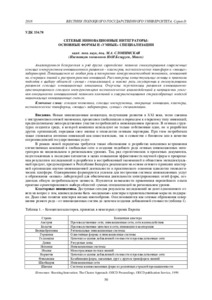Please use this identifier to cite or link to this item:
https://elib.psu.by/handle/123456789/23186Full metadata record
| DC Field | Value | Language |
|---|---|---|
| dc.contributor.author | Слонимская, М. А. | - |
| dc.date.accessioned | 2019-02-15T06:52:25Z | - |
| dc.date.available | 2019-02-15T06:52:25Z | - |
| dc.date.issued | 2018 | - |
| dc.identifier.citation | Вестник Полоцкого государственного университета. Серия D, Экономические и юридические науки. - 2018. - № 13. – С. 50-59. | ru_RU |
| dc.identifier.issn | 2070-1632 | - |
| dc.identifier.uri | https://elib.psu.by/handle/123456789/23186 | - |
| dc.description | Network Innovative Integrators: the Main Forms and “Smart” Specialisations M. Slonimska | ru_RU |
| dc.description.abstract | Анализируются белорусская и ряд других европейских политик стимулирования современных сетевых инструментов инновационного развития – кластеров, технологических платформ и «живых» лабораторий. Показывается их особая роль в построении конкурентоспособной экономики, основанной на генерации знаний и распространении инноваций. Рассмотрены концептуальные основы и практика подходов к выбору областей «умных» специализаций, а также роль государства в стимулировании развития сетевых инновационных инициатив. Очерчены перспективы развития инновационно- ориентированного сетевого инструментария технологических взаимодействий в направлении усиления открытости инновационной политики компаний и совершенствования спиралеобразных моделей национальных инновационных систем.= The Belarusian, а number of European and some of other policies of innovative new network tools development stimulation – clusters, technology platforms, Living Labs are analyzed in the article. The article shows their special role in building competitive economy, based on knowledge generation and diffusion of innovation. The authors consider the conceptual framework and approaches in practice of select the smart specialization areas, as well as state’s role in promoting а networking innovative initiative. The prospect for the development of innovation-based network tools technological interactions in the direction of strengthening the innovation policy of openness of companies and improving helix models of national innovation system are outlined. | ru_RU |
| dc.language.iso | ru | ru_RU |
| dc.publisher | Полоцкий государственный университет | ru_RU |
| dc.relation.ispartof | Веснік Полацкага дзяржаўнага ўніверсітэта. Серыя D, Эканамічныя і юрыдычныя навукі | be_BE |
| dc.relation.ispartof | Herald of Polotsk State University. Series D, Economics and law sciences | en_EN |
| dc.relation.ispartof | Вестник Полоцкого государственного университета. Серия D, Экономические и юридические науки | ru_RU |
| dc.relation.ispartofseries | Серия D, Экономические и юридические науки;2018. - № 13 | - |
| dc.rights | open access | ru_RU |
| dc.subject | Государственный рубрикатор НТИ - ВИНИТИ::ОБЩЕСТВЕННЫЕ НАУКИ::Экономика и экономические науки | ru_RU |
| dc.subject | Сетевая экономика | ru_RU |
| dc.subject | Сетевые инструменты | ru_RU |
| dc.subject | Открытые инновации | ru_RU |
| dc.subject | Кластеры | ru_RU |
| dc.subject | Технологические платформы | ru_RU |
| dc.subject | «Живые» лаборатории | ru_RU |
| dc.subject | «Умные» специализации | ru_RU |
| dc.subject | Network economy | ru_RU |
| dc.subject | Network tools | ru_RU |
| dc.subject | Open innovations | ru_RU |
| dc.subject | Clusters | ru_RU |
| dc.subject | Technological platforms | ru_RU |
| dc.subject | “Live” laboratories | ru_RU |
| dc.subject | “Smart” specializations | ru_RU |
| dc.title | Сетевые инновационные интеграторы: основные формы и «умные» специализации | ru_RU |
| dc.type | Article | ru_RU |
| dc.identifier.udc | 334.78 | - |
| Appears in Collections: | 2018, № 13 | |
Items in DSpace are protected by copyright, with all rights reserved, unless otherwise indicated.
